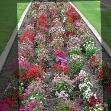| Image resampling can be achieved in a number of ways. Well-known methods are nearest-neighbor, bilinear, and cubic convolution. These resampling methods are compared in Fig. 1. The image of a penny is shown in Fig. 1a. Rotating the image by 10 degrees counter-clockwise and resampling it by nearest-neighbor, bilinear, and cubic convolution, the images shown in Figs. 1b - d are obtained. Resampling by cubic convolution appears visually similar to resampling by bilinear interpolation. The intensities estimated by the two methods are, however, different. Resampling by nearest-neighbor produces aliasing effects at sharp intensity changes. This aliasing effect is not visible in bilinear and cubic convolution methods due to the inherent smoothing involved in the process. Resampling by bilinear interpolation is several times slower than resampling by nearest-neighbor, and resampling by cubic convolution is several times slower than resampling by bilinear interpolation. |


(a) (b)


(c) (d)
Fig. 1. (a) An image of a penny. (b) - (d) Images resampled by the nearest-neighbor, bilinear, and cubic convolution,
respectively, after rotating image (a) by 10 degrees counter-clockwise about the image center.
respectively, after rotating image (a) by 10 degrees counter-clockwise about the image center.
To obtain software systems containing these resampling methods, see the List of Software Products.
| Image resampling |
| Image Registration and Fusion Systems |
